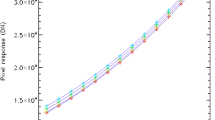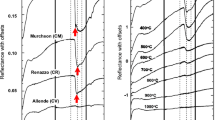Abstract
This paper presents some of the measured diurnal cycle temperatures and infrared signatures from targets of cuboids made by using Bakelite, aluminum and steel which are coated with the same paint used for the naval ships. The diurnal variations of the temperatures and the infrared images over the targets are measured together with the weather conditions and solar/sky irradiations. When the optical surface conditions are maintained the same for all the objects considered as in this study, we found that the object with low thermal conductivity results in higher surface temperature than those with high thermal conductivity under the direct sun light, The MWIR radiance clearly shows the similar trend as the surface temperature but the LWIR radiance is nearly unchanged for all the objects with different materials even their temperatures vary each other. Also we concluded that the relative contrast might be a useful parameter for determining that the object could be detected or not.
Similar content being viewed by others
References
J. H. Choi and T. K. Kim, Numerical and experimental studies on characteristic surface temperature variations of aluminum plates facing different direction. Journal of Mechanical Science and Technology, 24(12) (2010) 2561–2566.
F. D. Lapierre, R. Dumont, A. Borghgraef, J. P. Marcel and M. Acheroy, OSMOSIS: An open-source software for modeling of ship infrared signatures. 3rd international IR Target and Background Modelling & Simulation Workshop, (2007).
W. Pereira, D. Less, L. Rodriguez, A. Curran, U. Bernstein and Y. T. Kwan, Hyperspectral extensions in the MuSES signature code. Proceeding of SPIE, Modeling and Simulation for Military Operations III, 6965 (2008).
N. T. Duong and M. Wegener, Sensorvision validation: diurnal temperature variations in northern Australia. Proceeding of SPIE, Technologies for Synthetic Environments: Hardware-in-the-Loop Testing V, 4027 (2000).
M. A. Gilmore, C. K. Jones, A. W. Haynes, D. J. Tolhurst, T. Troscianko, P. G. Lovell, C. A. Parrega and K. Pickkavance, Use of vision model to quantify the significance of factor effecting target conspicuity. Proceeding of SPIE, Target and Backgrounds XII, 6239 (2006).
J. Latger, T. Cathala, N. Douchin and A. L. Goff, Simulation of active and passive infrared images using the SEWORKBENCH. Proceeding of SPIE, Infrared Imaging Systems: Design, Analysis, Modeling, and Testing XVIII, 6543 (2007).
S. D. Brown and J. R. Schott, Characterization techniques for incorporating background into DIRSIG. Proceeding of SPIE, Target and Background VI, 4029 (2000).
D. A. Vaitekunas, Validation of ShipIR (v3.2): methodology and results. Proceeding of SPIE, Target and Background VI, 6239 (2006).
C. Nelsson, P. Hermansson, T. Winzell and S. Stefan, Benchmarking and validation of IR signature programs: Sensorvision, Cameo-SIM and RadThermIR. RTO SCI Symposium, RTO-MP-SCI-145 (2004).
A. Reinov, Y. Bushlin, A. Lessin and D. Clement, Dew, dust, and wind influencing thermal signatures of objects. Proceeding of SPIE, Infrared Imaging Systems: Design, Analysis, Modeling, and Testing XIX, 6941 (2008).
J. H. Choi and T. K. Kim, Characteristics analysis of IR signatures by using the computer modeling and field measured for different optics surface properties. Proceeding of SPIE, 7830 (2010).
M. A. Torres and D. W. Hoock, Representation of meteorological visibility in real-time simulation of targets and backgrounds. Proceeding of SPIE, Target and Backgrounds: Characterization and Representation, 6239 (1995).
Author information
Authors and Affiliations
Corresponding author
Additional information
Recommended by Associate Editor Dongsik Kim
Jun-Hyuk Choi received his M.S. and Ph.D. in the school of Mechanical Engineering from Chung-Ang University, Korea, in 2004 and 2009, respectively. His research interests include IR signature modeling and analysis.
Tae-Kuk Kim received his M.S. in the school of Mechanical Engineering from Korea Advanced Institute of Science and Technology, Korea, in 1979. He received M.S. and Ph.D. in Mechanical Engineering from University of Minnesota, United States of America in 1986 and 1990, respectively. His current research interests are combined heat transfer and radiative energy transmission.
Rights and permissions
About this article
Cite this article
Choi, JH., Kim, TK. Experimental study on diurnal IR signature characteristics of cuboids with different materials. J Mech Sci Technol 27, 575–581 (2013). https://doi.org/10.1007/s12206-012-1234-5
Received:
Revised:
Accepted:
Published:
Issue Date:
DOI: https://doi.org/10.1007/s12206-012-1234-5




